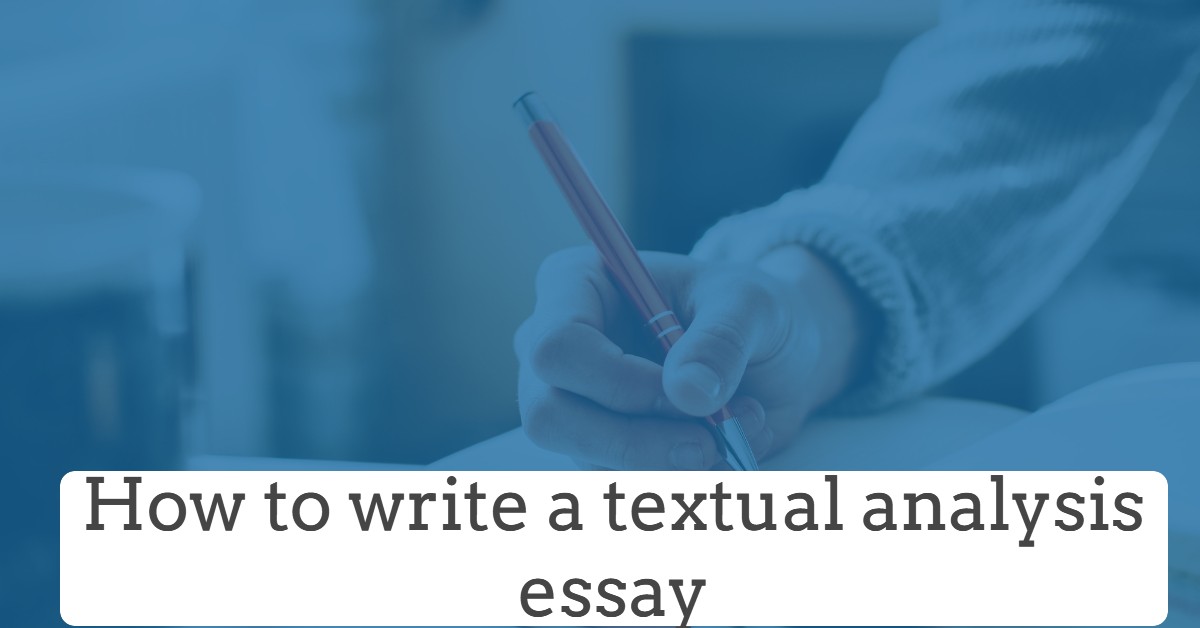I will love to show you step by step guide on how to write a textual analysis essay.

Writing a textual analysis essay is not as difficult as people say. Following these simple guidelines will help you write a superb textual analysis essay.
Essay writing is the art of creating a piece that expresses your point of view. As a result, an essay is commonly defined as a short piece of writing outlining the writer’s point of view or story.
But, what is a textual analysis essay?
What is a textual analysis essay?
Textual analysis entails closely studying a text, interpreting its meanings, and delving into why the author made certain decisions. It can be used to describe novels, short stories, plays, poems, or any other type of literary writing.
A textual or literary analysis essay is not a rhetorical analysis, nor is it simply a plot summary or a book review.
Instead, it is a type of argumentative essay in which you must analyze elements of the text, such as language, perspective, and structure and explain how the author uses literary devices to create effects and convey ideas.
Read More: 6th Grade Argumentative Essay Topics (Collection of Over 130)
Tips for Writing a Textual Analysis Essay
Textual analysis essays are written following the standard structure of an academic essay.
Every essay has the following structure:
- An introduction (the first paragraph)
- The thesis statement (last sentence of the introduction paragraph)
- The body of the work (divided into paragraphs, say 3)
- A conclusion.
Before beginning a textual analysis essay, read the text carefully and develop a thesis statement to keep your essay focused.
After that, write an outline, which will provide you with a writing plan. A detailed plan is a key to success!
At the beginning of your paper, include the author’s name and the title of the literary work under analysis.
How to start a textual analysis essay
- Start with a summary of the text.
- Use quotes from the text.
- Introduce the topic.
- Do your best to engage the reader.
How to Write a Textual Analysis Essay

What are the required steps in writing an outstanding textual analysis essay? There are seven simple and recommended steps to follow. Viz:
Step 1: Reading the text and identifying literary devices
The first step is to thoroughly read the text(s) and make preliminary notes.
Pay attention to the things in the writing that are most intriguing, surprising, or even confusing as you read—these are the things you can delve into in your analysis.
The goal of the textual analysis is not simply to explain the events described in the text but also to analyze the writing and discuss how the text works on a deeper level.
You’re primarily looking for literary devices, which are textual elements used by writers to convey meaning and create effects.
When comparing and contrasting multiple texts, you can also look for connections between them.
Vital literary devices to look out for
To get started with your analysis, there are several key areas that you can focus on.
As you analyze each aspect of the text, try to think about how they all relate to each other.
You can use highlights or notes to keep track of important passages and quotes.
The critical literary devices to look out for include:
1. Language choices
Consider the author’s linguistic style. Are the sentences brief and straightforward, or complex and poetic?
What word choices stand out as unusual or interesting?
Is it possible for words to be used figuratively to mean something other than their literal definition?
Figurative language includes metaphor (e.g., “her eyes were oceans”) and simile (e.g., “her eyes were like oceans”), among other things.
Keep an eye out for imagery in the text as well—recurring images that create a particular atmosphere or represent something significant.
Remember that language is used in literary texts to say more than what it appears to say.
2. Narrative voice
Find the answers to the following two questions: Who is the narrator of the story? And how do they tell it?
Is it a first-person (“I”) narrator who is personally involved in the story or a third-person narrator who tells us about the characters from afar?
Consider the narrator’s viewpoint. Is the narrator omniscient (knowing everything about all the characters and events) or only partially aware? Are they untrustworthy narrators whose words should not be taken at face value?
The tone of the text should also be considered. Is the story meant to be humorous, tragic, or something else? Is it more common for serious topics to be treated as funny, or vice versa? Or is the story realistic, fantastical, or somewhere in the middle?
3. Structure
Consider the structure of the text and how it relates to the story being told.
- Novels are frequently divided into chapters and sections.
- Lines, stanzas, and sometimes cantos are used to divide poems.
- Scenes and acts are used to divide plays.
Consider why the author chose to divide the text in the manner that they did.
There are also less formal structural elements to consider. Is the story told in chronological order, or does it skip around in time? Or is it set in the middle of the action, in medias res? Is the plot progressing toward a clearly defined climax?
Consider how the rhyme and meter shape your understanding of the text and your impression of the tone when writing poetry. To get a sense of this, try reading the poem aloud.
You might think about how different scenes build up characters’ relationships and how the setting relates to the action in a play. Keep an eye out for dramatic irony, which occurs when the audience knows something that the characters do not, resulting in a double meaning in their words, thoughts, or actions.
Step 2: Writing your thesis statement
In a textual analysis essay, your thesis statement is the point you want to make about the text. The core argument steers your essay and keeps it from becoming a collection of random observations about a text.
If you are given a prompt for your essay, your thesis statement must respond to or relate to the prompt.
You may be given the option of selecting your topic; in this case, you must develop an original thesis.
How to discover your thesis
- Think about what stood out to you in the text.
- Consider asking yourself questions about the elements that piqued your interest and assessing how you might respond to them.
Note:
Your thesis should be debatable—that is, something you believe is true about the text but is not a simple matter of fact. It must be complex enough to develop over the course of your essay through evidence and arguments.
Remember that you can revise your thesis statement throughout the writing process, so it doesn’t have to be perfect at this point.
The goal is to keep you focused on the text as you analyze it.
Step 3: Finding textual evidence
Your essay will construct an argument based on textual evidence to support your thesis statement. Textual evidence refers to specific passages in a text that support your argument.
This evidence is quoted and analyzed throughout your essay to help the reader understand your point of view.
Before you begin writing, comb through the text for relevant quotations.
You may not use everything you find, and you may need to go back to the text for more evidence as you write, but gathering textual evidence from the start will help you structure your arguments and assess whether they are persuasive.
Step 4: Writing a title
You’ll need a good title for your textual analysis paper to get started.
Your title should make it clear what your analysis will be about.
It usually includes the author’s name as well as the text(s) you’re analyzing. Keep it as short and exciting as possible.
A standard title format starts with a relevant quote from the text, followed by a colon, and then the rest of the title.
Don’t worry if you have trouble coming up with a good title at first; it will become easier once you’ve started writing the essay and have a better understanding of your arguments.
Step 5: Writing a good introduction
The essay introduction gives a quick overview of the main points of your argument. It should include a summary of the essay’s structure as well as your thesis statement.
An introduction’s typical structure starts with a general statement about the text and author, then transitions into your thesis statement. You could bring up a commonly held belief about the text and show how your thesis will refute it, or you could zoom in on a specific device you want to focus on.
Then, as a final touch, give a preview of what’s to come in the essay’s main body. This is referred to as signposting. It will be more elaborate in more extended essays, but it should not be more than one sentence in a five-paragraph essay structure.
It’s not a bad idea for some students to write the introduction later in the process. After all, once you start writing, you’ll have a better idea of the overall shape of your arguments!
Even if you write the introduction first, you should go back to it later to make sure it matches what you ended up writing and make any necessary changes.
Step 6: Writing the body of the essay
The body of your essay is everything between the introduction and conclusion. It contains your arguments and the textual evidence that supports them.
Note the following as you write the body of your textual analysis essay:
1. Paragraph structure
A typical high school textual analysis essay structure consists of three body paragraphs plus an introduction and conclusion.
Each paragraph in the main body should concentrate on a single topic. Try to divide your argument into three main areas of analysis in the five-paragraph model, all of which are related to your thesis. Don’t include everything you can think of to say about the text; instead, include only the analysis that supports your point of view.
The same principle applies on a larger scale in more extended essays. For example, in your main body, you could have two or three sections, each with multiple paragraphs. Within these sections, you should start new paragraphs at logical points in the argument, such as a turn in the argument or introducing a new idea.
2. Topic sentences
It is critical to use a topic sentence at the beginning of each paragraph to keep your points focused.
A good topic sentence lets the reader know what the paragraph is about at a glance. It can start a new line of thought and connect or contrast it with the previous paragraph.
Transition words such as “however” or “moreover” can help to create smooth transitions.
3. Using textual evidence
Backing up your arguments with relevant evidence from the text is an integral part of textual analysis.
This entails introducing quotations from the text and explaining their relevance to your point.
It’s critical to contextualize quotes and explain why you’re using them; they should be introduced and analyzed correctly rather than being treated as self-explanatory.
Step 7: Writing a conclusion
You summarize your main points in the conclusion and try to emphasize their importance to the reader.
Your analysis’ conclusion should not include any new quotations or arguments. Instead, it’s about completing the essay.
A good approach is to briefly summarize your key arguments and then emphasize the conclusion they’ve led you to, affirming the new perspective your thesis provides on the text as a whole.
Must Read: How to Write a Business Loan Application Letter
Textual analysis essay topics for you
Examine the following list of exciting topics for a textual analysis essay and select the one that appeals to you the most:
- Choose any play by Shakespeare and analyze it.
- Write a textual essay on the poetry of Robert Burns.
- Write an analysis of the literary work “To Kill a Mockingbird.”
- Provide the textual analysis of the Bible story.
- Write a Great Gatsby essay.
- Analyze the characters of M. Twain.
- A textual analysis of a famous speech of President Donald Trump.
- Choose successful/unsuccessful advertising and provide textual evidence of why it is successful/unsuccessful.
- Choose a slogan of some renowned company and analyze its text quality.
- A textual analysis of a religious text.
For more essay topics, read>>> 6th-grade essay topics
The Dos and Don’ts of Textual Analysis Papers
Take the following instructions to heart:
| DO NOT | DO |
| Only summarize plot | Analyze the thematic and symbolic significance of events in the story |
| Say you didn’t like a character | Explain how a character was unlikeable, how that affects the reading experience, and why that may or may not have been the author’s intent |
| Generalize and provide vague reasons behind your Text Analysis | Use specific examples from the text(including quotes, if significant). |
| Make superficial, obvious insights (poor thesis) | Think deeply, and look closely into the work. Notice things that a casual reader would not. |
| Simply repeat ideas mentioned in class by the instructor or by other students. | Build off ideas mentioned in class, adding your own thoughts and insights to the discussion. |
Here you have it! We have greatly simplified how to write a textual analysis essay. Follow the steps outlined, be creative and innovative in your writing and write a superb textual analysis essay.
If you have any questions, comments or contributions, use the comment section of this post.
Please share this information with others.
Recommended:
Top 20 IT Certification Courses in Nigeria
National Junior Honor Society Application Guide and Essay Examples
Best Poetry Scholarships for High School Students (2023 Guide)

